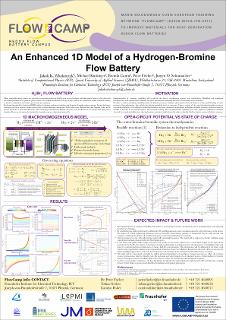Please use this identifier to cite or link to this item:
https://doi.org/10.21256/zhaw-2791| Publication type: | Conference poster |
| Type of review: | Editorial review |
| Title: | An enhanced 1-D model of a hydrogen-bromine flow battery |
| Authors: | Wlodarczyk, Jakub Cantu, Brenda Fischer, Peter Küttinger, Michael Schumacher, Jürgen |
| DOI: | 10.21256/zhaw-2791 |
| Proceedings: | 16th symposium on modeling and experimental validation of electrochemical energy technologies (ModVal 2019) : book of abstracts |
| Editors of the parent work: | Krewer, Ulrike Laue, Vincent Redeker, Andreas |
| Conference details: | ModVal 2019, Braunschweig, Germany, 12-13 March 2019 |
| Issue Date: | 2019 |
| Publisher / Ed. Institution: | Technische Universität Braunschweig |
| Language: | English |
| Subjects: | Hydrogen-bromine redox flow battery; Modeling and simulation |
| Subject (DDC): | 621.3: Electrical, communications, control engineering |
| Abstract: | One of the flow battery systems which utilizes abundantly available chemicals for electrolytes, characterized by high power density, is the hydrogen-bromine flow battery. First proposed in 1969 [1], it has recently received new attention and has been undergoing development, in which numerical simulations play an important role. To date, a few papers devoted to modeling and simulation of this particular new-generation flow battery chemistry were published. In the present work, a one-dimensional (1D), steady-state, macrohomogeneous, mathematical model of a single-cell hydrogen-bromine flow battery (HBFB) is developed, described and solved. It comprises of the most relevant transport through-plane processes and electrochemical phenomena for the operation of the HBFB, namely: charge transport, water, gaseous hydrogen, proton, bromine and (tri)bromide mass transport. Furthermore, the model is enhanced with supplementary phenomena to better approximate the physics described in the simulation such as: bromine-tribromide ionic equilibria, Nernstian losses due to reactant local surface concentration variations, Donnan potential on the HBr/Br2 solution-membrane interface, and gas adsorption in the ionomer on the gaseous hydrogen side according to Henry’s law. The model description emphasizes the importance of electrochemical and flux sign conventions, and the meaning of appropriate boundary conditions, which was seldom the case in the published modeling approaches. A complete set of plots of each dependent variable and the associated fluxes are provided. A system of nonlinear second-order partial differential equations describing the problem is solved using COMSOL Multiphysics software with the General PDE Form module for a better control over the actual governing equations (conservation laws) as well as auxiliary algebraic field equations. The 1D approach allows for solving the problem within seconds on a laptop-class computer and permits running multiple case studies within short time. Moreover, a parametric study is performed (Fig. 1) to examine the impact of selected parameters on the overall performance of a single cell. The validity of the model is verified based on results from a set of experiments carried out at Fraunhofer ICT (internal, multidisciplinary cooperation within the Flowcamp* project) using an isothermal single test cell. |
| Further description: | Acknowledgements: This project has received funding from the European Union’s Horizon 2020 research and innovation programme under the Marie Skłodowska-Curie Grant Agreement no. 765289. *Project website: www.flowcamp-project.eu |
| URI: | https://digitalcollection.zhaw.ch/handle/11475/16161 |
| Fulltext version: | Accepted version |
| License (according to publishing contract): | Not specified |
| Departement: | School of Engineering |
| Organisational Unit: | Institute of Computational Physics (ICP) |
| Published as part of the ZHAW project: | Redox Flow Battery Campus |
| Appears in collections: | Publikationen School of Engineering |
Files in This Item:
| File | Description | Size | Format | |
|---|---|---|---|---|
| Wlodarczyk-Poster-Final-Modval2019.pdf | 8.57 MB | Adobe PDF |  View/Open |
Show full item record
Wlodarczyk, J., Cantu, B., Fischer, P., Küttinger, M., & Schumacher, J. (2019). An enhanced 1-D model of a hydrogen-bromine flow battery [Conference poster]. In U. Krewer, V. Laue, & A. Redeker (Eds.), 16th symposium on modeling and experimental validation of electrochemical energy technologies (ModVal 2019) : book of abstracts. Technische Universität Braunschweig. https://doi.org/10.21256/zhaw-2791
Wlodarczyk, J. et al. (2019) ‘An enhanced 1-D model of a hydrogen-bromine flow battery’, in U. Krewer, V. Laue, and A. Redeker (eds) 16th symposium on modeling and experimental validation of electrochemical energy technologies (ModVal 2019) : book of abstracts. Technische Universität Braunschweig. Available at: https://doi.org/10.21256/zhaw-2791.
J. Wlodarczyk, B. Cantu, P. Fischer, M. Küttinger, and J. Schumacher, “An enhanced 1-D model of a hydrogen-bromine flow battery,” in 16th symposium on modeling and experimental validation of electrochemical energy technologies (ModVal 2019) : book of abstracts, 2019. doi: 10.21256/zhaw-2791.
WLODARCZYK, Jakub, Brenda CANTU, Peter FISCHER, Michael KÜTTINGER und Jürgen SCHUMACHER, 2019. An enhanced 1-D model of a hydrogen-bromine flow battery. In: Ulrike KREWER, Vincent LAUE und Andreas REDEKER (Hrsg.), 16th symposium on modeling and experimental validation of electrochemical energy technologies (ModVal 2019) : book of abstracts. Conference poster. Technische Universität Braunschweig. 2019
Wlodarczyk, Jakub, Brenda Cantu, Peter Fischer, Michael Küttinger, and Jürgen Schumacher. 2019. “An Enhanced 1-D Model of a Hydrogen-Bromine Flow Battery.” Conference poster. In 16th Symposium on Modeling and Experimental Validation of Electrochemical Energy Technologies (ModVal 2019) : Book of Abstracts, edited by Ulrike Krewer, Vincent Laue, and Andreas Redeker. Technische Universität Braunschweig. https://doi.org/10.21256/zhaw-2791.
Wlodarczyk, Jakub, et al. “An Enhanced 1-D Model of a Hydrogen-Bromine Flow Battery.” 16th Symposium on Modeling and Experimental Validation of Electrochemical Energy Technologies (ModVal 2019) : Book of Abstracts, edited by Ulrike Krewer et al., Technische Universität Braunschweig, 2019, https://doi.org/10.21256/zhaw-2791.
Items in DSpace are protected by copyright, with all rights reserved, unless otherwise indicated.